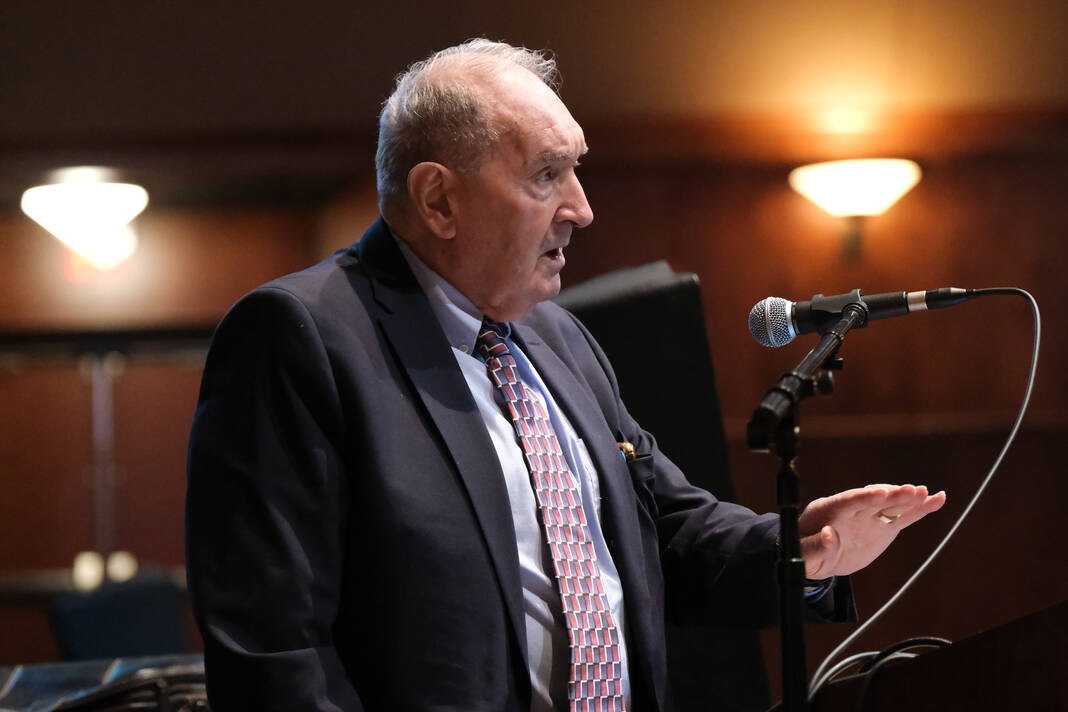
William Phillis, executive director at the Ohio Coalition for Equity and Adequacy of School Funding, speaks to a group Thursday at the Bowling Green City Schools Performing Arts Center.
J.D. Pooley | Sentinel-Tribune
In the past two years, $500,000 has left the Bowling Green City Schools district — and is funding private school vouchers.
Board of education member Ginny Stewart said she started tracking the money in 2020, where a line item showed that $138,855 was depleted from the BG coffers for vouchers. In 2021, that increased to $341,811.
For a district with 2,900 students, losing half a million dollars is a big hit, Stewart said.
She spoke during a Thursday forum,”Vouchers Hurt Ohio, the Existential Threat,” held at the Bowling Green Performing Arts Center. About 50 people, mostly educators or board of education members, attended the session, which explained a lawsuit against the state.
The Bowling Green district is one of 125 Ohio school districts challenging the constitutionality of EdChoice. Stewart is on the steering committee of Vouchers Hurt Ohio.
William Phillis, executive director at the Ohio Coalition for Equity and Adequacy of School Funding, said that public school funding is a state responsibility.
The Vouchers Hurt Ohio litigation was filed Jan. 1 in Franklin County Common Pleas Court.
“We believe that we are going to win this case,” said Phillis, who was involved in DeRolph v. State of Ohio.
In that case, the Ohio Supreme Court ruled that the state’s method for funding public education was unconstitutional. That was in 1991 and the state legislature has not made a new decision on school funding.
The voucher case will be different, Phillis said.
If a ruling is in Vouchers Hurt Ohio’s favor, the voucher program will cease, he said.
“We have the right cause. The cause is to save the public common school system. I think that needs to be ingrained in your head,” Phillis said. “There are many forces out there that would privatize the whole system.”
He asked the audience to imagine the “monstrosity” of 1.6 million young people, with all of the state education money going to parents and guardians. It would be impossible to manage, Phillis said.
Jeff Nichols, a Bowling Green teacher, said that a dollar out for private schools is a dollar less for public schools.
When the state siphons hundreds of millions of dollars to give to private schools, the local districts are devastated, he said.
“We face the tough choice of going back to our voters and raising taxes, or cutting jobs, cutting benefits or cutting programs,” Nichols said.
“We need to stand together,” he said, urging other school districts to join the lawsuit.
Dan Heintz is a public school teacher, member of the Cleveland Heights-University Heights Board of Education, and on the steering committee of the Vouchers Hurt Ohio lawsuit.
He said $25 billion in tax dollars have gone to vouchers and charter schools since 2000.
“Ohio’s legislature has failed two entire generations of Ohioans by neglecting their constitutional duty to fund our public schools,” Heintz said.
The voucher program was started to help impoverished families trapped in poor performing districts.
However, the majority of the money has gone to reimburse families already committed to private schools, Heintz said.
“There’s a lack of accountability and they are unregulated,” he said of private schools.
Heintz also talked about House Bill 290, which would make every Ohio child and school voucher eligible. There are similar bills in Texas, Florida and Oklahoma, he said.
“West Virginia is giving vouchers to parents to homeschool their children,” Heintz said.
“Where does the Ohio General Assembly get the power to fund private school vouchers?” he said. “The power is not to be found in the Ohio Constitution.”
Several Wood County schools have been affected by EdChoice, including Kenwood Elementary in Bowling Green, Lake middle and high schools, and Northwood elementary and high school.
The Educational Choice Scholarship (EdChoice) Program provides students from under-performing public schools the opportunity to attend participating private schools. The annual EdChoice scholarship amount is $4,650 for grades K-8 and $6,000 for grades 9-12. The program was halted during the pandemic.
Heintz said that private schools are educating 10% of Ohio students — but are getting 25% of the Ohio dollars allocated for education.
Another way to look at that: Public schools are educating 90% of the students and are operating with 75% of the dollars, he said.
“We believe the EdChoice program should be ruled invalid and void,” he said.
The program is also segregating schools, Heintz said. He used the Richmond Heights community as an example.
Pre-EdChoice, the school district was 25% white; post-EdChoice, 3% of the students are white, he said.
“What’s wrong with this picture? Everything’s wrong with this picture,” Heintz said. “It’s resegregating our schools and that is unfair,” he said.
Also, 90% of the private schools receiving EdChoice dollars are parochial, he said.
Cleveland Heights-University Heights School District, where Heintz is a board of education member, lost $27 million to EdChoice.
“But the district has the same amount of students to educate,” he said. “We had to go to the voters and ask for a levy twice.”

